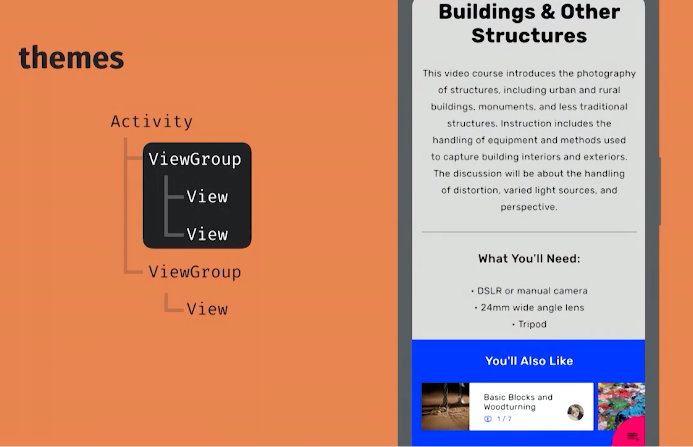Is there any way to get color information from color resources? I'm trying to get the red, blue, and green components of the colors defined in the resource (R.color.myColor) so that I can set the values of the three search bars to a specific level.
#1 building
Define your color
Value / color.xml
<?xml version="1.0" encoding="utf-8"?> <resources> <!-- color int as #AARRGGBB (alpha, red, green, blue) --> <color name="orange">#fff3632b</color> ... <color name="my_view_color">@color/orange</color> </resources>
Get color int and set it
int backgroundColor = ContextCompat.getColor(context, R.color.my_view_color); // Color backgroundColor = ... (Don't do this. The color is just an int.) myView.setBackgroundColor(backgroundColor);
You can also have a look
#2 building
Based on the new Android support library (and this Update), you should now call:
ContextCompat.getColor(context, R.color.name.color);
according to File :
public int getColor (int id)
This method is not recommended in API level 23. Use getColor (int, Theme) instead
It is the same as the getResources().getColorStateList(id) solution:
You must change it like this:
ContextCompat.getColorStateList(getContext(),id);
Editor 2019
About the context in which ThemeOverlay uses the closest view:
val color = ContextCompat.getColor( closestView.context, R.color.name.color )
In this way, you can get the correct color according to ThemeOverlay.
It is especially necessary to use different themes (such as dark / Light Themes) in the same activity. If you want to learn more about themes and styles, we recommend the following discussion: Using styles to develop themes
#3 building
I updated to use contextcompat.getcolor (context, r.color. Your [color]); but sometimes (on some devices / Android versions). I'm not sure) will cause NullPointerException.
So to make it work on all devices / versions, I'll use the old method with null pointers.
try { textView.setTextColor(ContextCompat.getColor(getActivity(), R.color.text_grey_dark)); } catch(NullPointerException e) { if(Build.VERSION.SDK_INT >= Build.VERSION_CODES.M) { textView.setTextColor(getContext().getColor(R.color.text_grey_dark)); } else { textView.setTextColor(getResources().getColor(R.color.text_grey_dark)); } }
#4 building
Best method
As @ sat's answer, a good way to get color is
ResourcesCompat.getColor(getResources(), R.color.your_color, null);
Or use the following method when the getResources() method cannot be accessed.
Context context = getContext(); // like Dialog class ResourcesCompat.getColor(context.getResources(), R.color.your_color, null);
What I have to do is
public void someMethod(){ ... ResourcesCompat.getColor(App.getRes(), R.color.your_color, null); }
It's easiest to use anywhere in your application! Even in a Util class or any class where you don't have Context or getResource()
Problem (when you don't have a context)
When you don't have Context access, it's like a method in a Util class.
Suppose the following method has no context.
public void someMethod(){ ... // can't use getResource() without Context. }
Now, you will pass Context as a parameter in this method and use getResources()
public void someMethod(Context context){ ... context.getResources... }
So here's a unique Bonus solution that allows you to access Resources from anywhere like Util class. Add Resources to your Application class, or create one if it doesn't exist.
import android.app.Application; import android.content.res.Resources; public class App extends Application { private static App mInstance; private static Resources res; @Override public void onCreate() { super.onCreate(); mInstance = this; res = getResources(); } public static App getInstance() { return mInstance; } public static Resources getResourses() { return res; } }
Add the name field to the manifest. XML < application tag. (if not already added)
<application android:name=".App" ... > ... </application>
Now you're fine. Use resourcescompat. Getcolor (app. Getres(), r.color. Your color, null); anywhere in the app.
#5 building
Accessing colors from inactive classes can be difficult. One of the alternatives I found was to use enum. Enum provides a lot of flexibility.
public enum Colors { COLOR0(0x26, 0x32, 0x38), // R, G, B COLOR1(0xD8, 0x1B, 0x60), COLOR2(0xFF, 0xFF, 0x72), COLOR3(0x64, 0xDD, 0x17); private final int R; private final int G; private final int B; Colors(final int R, final int G, final int B) { this.R = R; this.G = G; this.B = B; } public int getColor() { return (R & 0xff) << 16 | (G & 0xff) << 8 | (B & 0xff); } public int getR() { return R; } public int getG() { return G; } public int getB() { return B; } }
